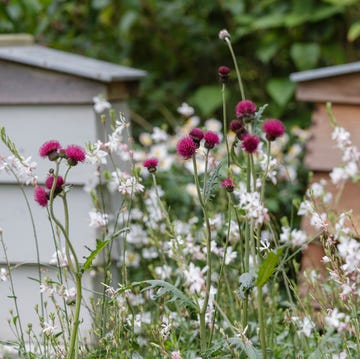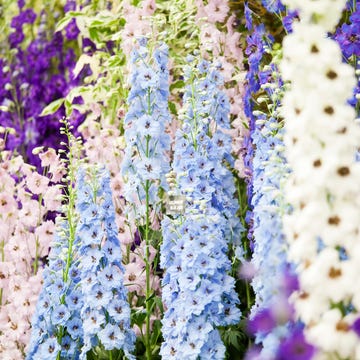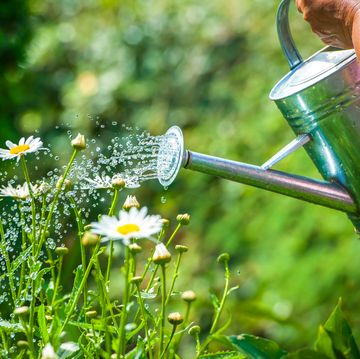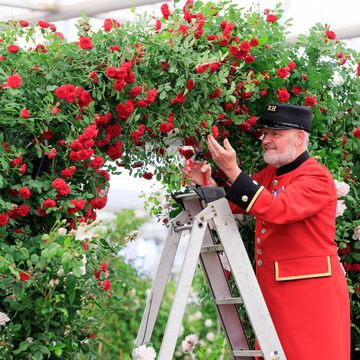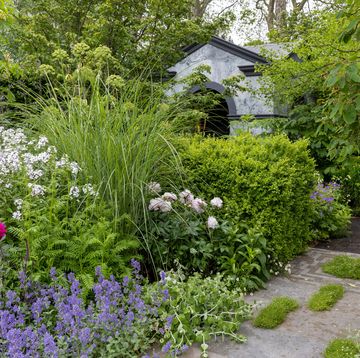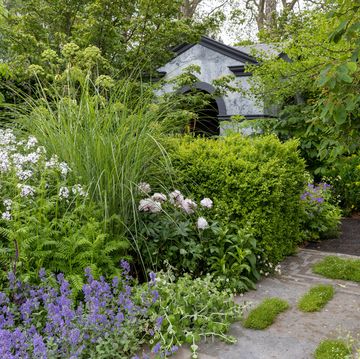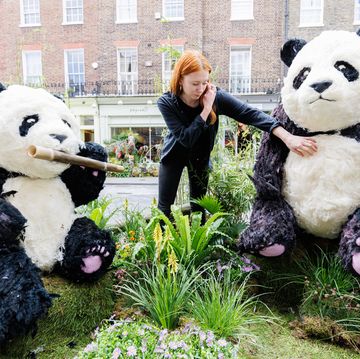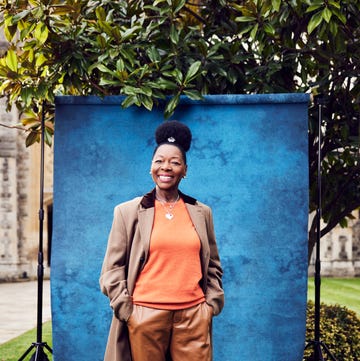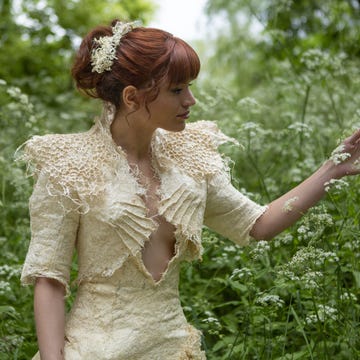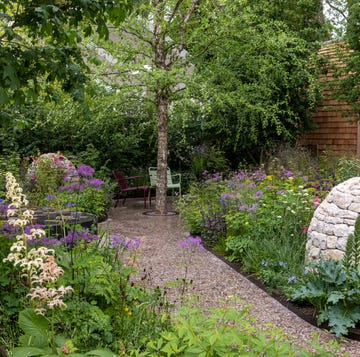The Fauna & Flora Garden by Jilayne Rickards wins Silver Medal in the Show Gardens category. See here for the full list of Gold, Silver Gilt, Silver and Bronze Medal awards.
Making its RHS Chelsea Flower Show debut with a 2023 Show Garden, designed by Gold Medal-winner Jilayne Rickards, international wildlife conservation charity Fauna & Flora will bring to life the journey of an eco-tourist on a gorilla trek through the lush and changing landscape of Central Africa’s Afromontane region.
Along the way, the garden will celebrate the International Gorilla Conservation Programme (originally established by Fauna & Flora as the Mountain Gorilla Project), with support from Sir David Attenborough, the charity’s vice president.
Fauna & Flora tells Country Living it has been working to conserve mountain gorillas since 1978, when Sir David Attenborough asked for a meeting to discuss what could be done to save these great apes. He had just returned from filming mountain gorillas for the BBC’s Life on Earth documentary series and was acutely aware of the grave threat they were facing.
These conversations led to the International Gorilla Conservation Programme (IGCP), a collaboration between multiple conservation partners.
What inspired the Fauna & Flora Garden?
“In 2019, I was talking to a friend I went to school with. Her husband is a zoologist,” designer Jilayne tells Country Living. “I was saying, ‘all I’ve got is a set of design skills’ and I really want to do more to raise awareness of wildlife. He told me about the work the FFI do to save gorillas.”
She started the design process in 2019 and kept going through the pandemic. “I had to go out there and see the project,” she continues. “I went out on a typical gorilla trek, in a protected forest area. I was really privileged to see these gorillas and that landscape.”
Jilayne was keen to make her design authentic. That’s why she has included a tourist kiosk, because local people are benefiting from eco-tourism arising from gorilla conservation.
“We were also keen on constructing the whole garden in a very sustainable way,” she adds. “It’s cement- and concrete-free."
Other sustainable elements include boulders that were waste from an agricultural project in Scotland and PAS 100 compost. “It’s the recycled compost, the sort you get from the council which has recycled household waste. If you can, I really recommend it. You buy it loose too, which avoids waste on bags.”
Design features
- A true-to-life gorilla nest set among bamboo and other typical gorilla food plants.
- Brightly painted tourist gift kiosk, brimming with artisanal craft goods.
- Dramatic waterfall, constructed from large boulders resembling those found in the Afromontane landscape.
- Viewing rock surrounded by plants commonly found at high altitude. The five-metre-high hill is made using a bag system, Rootlok, by GeoGrow.
- The ‘forest boundary wall’ – separating the human habitat from the protected forest area – constructed from dark igneous Gabbro stones.
- Colourful bicycle, which would be used for transporting charcoal and other materials.
- Beehives made from hollowed-out trunks, covered and tied together with banana leaves, dotted along the boundary wall. Honey is important for supporting local livelihoods. The beehives help deter illegal harvesting of honey in the forest, which can lead to fires when the bees are smoked out.
Jilayne – who won Gold and the People’s Choice Award at RHS Chelsea in 2019 for a garden she designed for CAMFED, another Africa-based charity – is working in collaboration with The Eden Project in Cornwall.
Amongst other authentic features, her garden will show a true-to-life gorilla nest set amongst bamboo and other typical gorilla food plants.
“These plants we are using are so unusual, it means getting people to grow them for us. Eden Project is growing 80 of our plants,” she tells us. “Because they have the right conditions there, and it’s a circular thing. When Chelsea is over, the garden will be going to The Eden Project as its permanent home.”
Some of the plants The Eden Project is raising for this Chelsea garden include:
- Clerodendron splendens – A fabulous, fast-growing climber with red flowers, to grow up trees and cascade over boulders. Needs a lot of space.
- Costus spiralis (Spiral Ginger) – Wonderful glossy, green leaves from its main stem have an interesting spiralling habit. It's a useful addition to the medicinal area as it is used to treat diabetes, urinary infections and kidney stones.
- Moringa oleifera (Miracle Tree) – This tree has dainty vibrant green leaves. Its common name of Miracle Tree is for its mass of medicinal benefits. All parts are used as medicine, with the seeds used as water purification.
- Tabernanthe iboga – This evergreen rainforest shrub is native to Central Africa and is used in traditional medicine. It produces hallucinations but is also used as a remedy to help with drug addiction. With a gorgeous open twiggy habit, it will be used in the medicinal area and the protected forest area.
- Thaumatococcus danielli (Miracle Fruit, Sweet Prayer Plant) – With beautiful, large, glossy, oval leaves on gracefully slender stems, this plant is native to Western Africa. Used as a low-calorie sweetener, the fruit is also a laxative and the seeds are used for pulmonary problems.
The Fauna & Flora Garden is sponsored by Project Giving Back, a platform founded in 2021 by two anonymous RHS Life Members to give financial support to charities and non-profit organisations who want to raise awareness of their work at RHS Chelsea.
“This Show Garden will provide Fauna & Flora with an invaluable opportunity to raise awareness of its global conservation work, including projects disrupted by the global pandemic,” says Mark Rose, CEO. “It comes at a time when recognising the links between nature protection, climate action and human well-being is more important than ever.”
Since Fauna & Flora first began working with mountain gorillas 40 years ago, numbers have increased from just a few hundred to more than 1,000 today. The charity tells Country Living that this is “a testament to the hard work and collaborative efforts of all those working to save these incredible primates.”
What will happen to the garden after Chelsea?
With sustainability as a guiding theme throughout the garden, after the show it will be relocated to Tropical Biome of The Eden Project in Cornwall.
Who is Jilayne Rickards?
Growing up in the wild Cornish countryside, Jilayne says on her website that she spent her childhood studying “the ever-changing light, the sea and the high cliffs with their rugged rocks.”
In the 1980s, Jilayne left Cornwall for London to pursue training and, eventually, a career in garden design. In the capital, she found herself enjoying, according to her website, “the urban landscape, inspirational new and old architecture and the wide diversity of clients and schemes that London attracts."
After training in garden design at Capel Manor College in Enfield, she became a practising garden designer in 2002.
Within a decade, she was proud to join the elite few as a Registered Member of the Society of Garden Designers – there are just over 200 Registered Members in the UK due to the Society’s very exacting and high standards. Jilayne was also accepted as a registered designer at BALI (British Association of Landscaping Industries) in 2019, the same year the garden she designed for CAMFED (a pan-African movement supporting education for girls) won Gold at Chelsea and the coveted People’s Choice Award. The garden was then relocated to The Eden Project in Cornwall.
The year after, her Urban Retreat garden won four National BALI Awards. She says on her website: “This was an important garden showcasing that even small spaces can have environmental qualities at their heart, be beautiful and still win awards.”
Planting choices
(final decision to be made nearer to Chelsea)
Trees
- Dacroydes edulis
- Eucalyptus glaucescens
- Hagenia abyssinica
- Kigelia africana
- Musa acuminata (although Jilayne points out that this is technically a herb)
- Spathodea campanulata
Shrubs/Bamboo
- Camellia sinensis
- Clerodendron splendens
- Dracaena aubryana
- Ensete ventricosum
- Hagenia abyssinca
- Lobelia stuhlmannii
- Maesa lanceolata
- Maytenus acuminata
- Moringa stenopetala
- Pallisota hirsuta
- Phsychotria punctata
- Phyllostachys aureus
- Rhamnus prinoides
- Ricinus communis
- Rubus kirungensis, runssorensis
- Solanecio manii (Crassocephalum mannii)
- Tetradenia riparia
- Vernonia amygdalina
Herbaceous
- Acanthus pubescens
- Aneilema beninensis / aequinoctiale
- Anthriscus sylvestris
- Bidens
- Pilosa
- Brillantaisa cicatricose
- Carduus nyassanus
- Galium simense
- Gomphorcarpus physocarpa
- Impatiens burtonii
- Laportea aestuans
- Leucas lanata
- Peucedanum linderi
- Piper capense
- Plantago palmata
- Plectranthus amboinicus
- Rumex abyssinicus
- Scadoxus multiflorus
- Tagetes minuta
- Thaumatococcus danielli
- Tithonia diversifolia
- Urtica massaica
Ferns
- Cyathea manniana
- Pteris in variety
- Dryopteris in variety
- Drynaria laurentii (or sinica)
Climbers
- Solanum adoense
- Begonia glabra or hirtella
- Clerodendron thompsoniae
- Lagenaria siceraria





